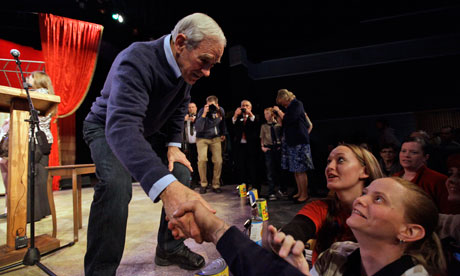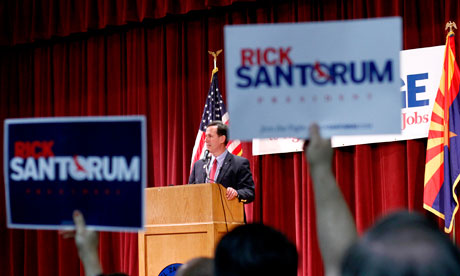Ron Paul quietly amassing an army of delegates while GOP frontrunners spar:

While the Republican nomination race is focused on the ongoing battle between frontrunners Mitt Romney and Rick Santorum, the Ron Paulcampaign is waging an under-the-radar "delegate strategy" that could make the libertarian-leaning Texan the surprise kingmaker of the race.
In states that have already voted via a caucus system – rather than a straight primary ballot – Ron Paul supporters are conducting an intensively organised ground effort aimed at securing as many convention delegate slots as possible, often in numbers that far outweigh the number of actual votes that Paul got in the ballot.
If successful, it means Paul's campaign could arrive at the August Tampa convention at the head of an army of delegates far larger than the proportion of votes that it won during the nomination contest.
It could also increase the chances of a contested convention – where no candidate has enough delegates to declare the winner – as well as give Paul much greater ability to inject his beliefs into the Republicans' 2012 policy platform.
The strategy is based on the fact the GOP race is in fact a "delegate contest" despite an overwhelming focus by the media and most campaigns on "winning" individual states by coming top of the popular vote. But in reality, each state, weighted proportionally by population, sends a number of delegates to Tampa where a nominee is then chosen.
A total of 2,286 delegates are sent to Tampa and so a candidate must secure the support of 1,144 of them in order to win the nomination.
However, a bewilderingly complex set of rules, often varying from state to state, exists to actually assign these delegates. Ron Paul's campaign is seeking to work that system in order to maximise its delegate count.
So far signs are that the campaign is being so successful at its strategy that it may be able to "win" delegate counts in states where it did not win the popular vote.
"They will be able to perform well enough that in some states where they came in third or fourth in the straw poll, they will come in first or second in terms of the delegate totals. I am fairly confident in making that bet," said Professor Josh Putnam, a political scientist at Davidson College who runs the Frontloading HQ blog dedicated to tracking the delegate fight.
How the strategy works
The strategy works because of the varying ways each state assigns the delegates that get sent to Tampa. Some states hold a "winner takes all" primary that will assign all its delegates to the candidate who tops the vote.
Others assign delegates proportionally according to the vote, splitting the delegates roughly according to the results and ensuring each major candidate gets some delegates.
But it is in the caucus states that the Ron Paul campaign is focused. There the method of assigning delegates is complex and lasts a long time. In caucus states that have voted so far like Iowa, Nevada, Colorado, Minnesota and Maine, the process of assigning delegates in support of each candidate has barely begun.
That process begins on caucus night when each precinct votes and then chooses delegates to send to a county convention to be held later in the year. Those county conventions will then choose a smaller number of delegates to send to a state convention or conventions held in each state's congressional districts.
Those state and district level conventions are the bodies that actually finally choose which delegates to send to the Tampa national convention.
However, at the start of the process – the precinct level meetings held on caucus day – the delegates selected to go to the later county conventions are frequently under no obligation to declare which candidate they are supporting or to support the "winner" of the day's actual voting.
Ron Paul's campaign strategy is to get enough of his precinct-level supporters to volunteer to become delegates to the county conventions so that they outnumber other campaigns. "Their strategy is to gobble up as many of these slots as they can," said Putnam.
Then, if you manage to stack the beginning of the process with Ron Paul delegates, as the system moves through the county conventions and the district and state-wide conventions the chances of Ron Paul-supporting delegates emerging at the end and being chosen to go to Tampa is greatly increased.
The entire strategy is helped by the fact that Paul's supporters are seen as far more organised and dedicated than other campaigns.
Is it successful?
It is currently impossible to say. No caucus state that has already voted has yet held any county conventions at which an idea of the number of Ron Paul-supporting delegates chosen at the precinct level may emerge. Those first indications should come in March.
However, the Ron Paul campaign itself, which is at pains to point out their strategy is entirely within the rules, has released information from Colorado that shows how they hope it could be playing out.
In one precinct in Larimer County there were 13 delegate slots available. Santorum had won the precinct's vote by 23 votes to Paul's 13, with five votes going to Romney. But Paul supporters took all the delegate slots.
In a Delta County precinct all five delegate slots went to Paul supporters though he came behind Santorum and Romney in the popular vote. In a Pueblo County precinct Paul supporters got the two delegate slots available despite the fact Paul finished fourth in the precinct's vote with just two actual votes.
Those examples are likely cherry-picked by the Paul campaign as best case scenarios. But Colorado party officials are – officially, at least – sanguine about what is going on as it obeys the party rules. "We are just here to play out the process. Whatever happens happens," executive director of the Colorado GOP Chuck Poplstein told the Guardian.
But Poplstein did say a successful delegate strategy was not easy to pull off. "It is difficult for any campaign. You have to be very well organised and in all of the counties. It is not an easy process. You have to have a very good ground game," he said.
But that might not be too much of a problem. The Ron Paul campaign is highly organised and focused. "We are also seeing the same trends in Minnesota, Nevada and Iowa, and in Missouri as well," the campaign said in its statement on the precinct performances in Colorado.
A recent report by the Washington Post from a caucus in Portland, Maine, revealed a dedicated activist organisation complete with pre-printed lists of which delegates should be voted for at the precinct level. That is likely true across all the caucus states.
"They do tend to be very organised and very enthusiastic for Ron Paul," said Professor Tim Hagle, a political scientist at the University of Iowa.
What impact could it have?
The fact is that Paul's delegate strategy would have little impact in a normal Republican race. The system is set up with enough winner-take-all and primary states to ensure that Paul's strategy has no chance whatsoever of picking up enough delegates via this method to actually win the nomination himself.
But it all changes when the Republican race becomes protracted and closely fought. If Santorum, Romney and Newt Gingrich all stay in the race beyond Super Tuesday and start to amass their own large piles of delegates, then reaching the vital 1,144 delegates needed to win starts to become more difficult.
If that scenario plays out – something most experts see as possible but unlikely – then Paul's delegate total becomes crucial. He could become a kingmaker, agreeing to throw his hefty delegate total behind one candidate who could then claim victory.
As a candidate with a very clearly defined agenda – on foreign policy, the role of government and fiscal issues, especially the Federal Reserve – Paul could demand a high policy price for that support.
However, even if a nominee emerges prior to the convention, Paul's delegates will still be important. If he amasses a loyal and large delegate total he will able to secure a high-profile, possibly primetime, speaking slot.
He will also be more able to get his agenda into the party's official policy platform. Given Paul's stance on issues like American foreign policy and the wars in Afghanistan, that could upset the party elite and the nominee.
Modern conventions are supposed to be highly organised, tightly controlled displays of party unity. At the very least a successful Paul delegate strategy could shatter that prospect.
Mitt Romney rebounds against the Santorum surge:

The Arizona and Michigan 28 February primaries are supposed to be "do or die" for Mitt Romney. And like his other "do or die" test in Florida, it seems that Romney may survive earlier predictions of his demise and live to see another day. Polling released in the past 24 hours indicates that Romney has increased his lead in Arizona and has re-gained the lead in Michigan.
Romney's resurgence marks yet another chapter in the 2012 primaries, which have been marked by sudden turns in candidates' momentum. Rick Santorum came out of nowhere to win Iowa, Newt Gingrich to win in Iowa, and Romney stormed back to win Florida. The problem for Santorum is that, by this point in all of those contests, the "comeback kid" was already making his ascent as seen in this aggregate HuffPollster chart from polls taken seven days before each caucus or primary.
Five days before the Iowa caucus, the illustrious pollster Ann Selzershowed Santorum gaining 12 points from his showing earlier in the week.Other polling also showed that Santorum was gaining quickly, and his strong finish was predicted well.
South Carolina polls illustrated a similar effect. Gingrich picked up 10 points in one night after the final debate, which was five days before the primary. This momentum continued through voting, and Gingrich won the state easily.
By this point (that is, five days out from voting) in Florida, Romney had recovered from 5 to 10 percentage-point deficit five days earlier and had taken a 10-15 percentage-point advantage over Gingrich. Romney's rapid recovery maintained momentum, and he won Florida by 14.5 percentage points.
In other words, going on past experience, there isn't much Santorum can do in the next 96 hours to overcome Romney.
In fact, right now, Santorum is going in the opposite direction of all these "comebacks". It was Santorum who led in most polling a week ago, so he has become the candidate in decline. The latest Mitchell/Rosetta Stone poll (pdf) finds Romney up 3 percentage points, but it was Santorum who led by 9 points on Valentine's Day. The latest Rasmussen poll givesRomney an even bigger 6-point lead, after he trailed by 4 points just three days ago. But perhaps the best indication of Romney's rise is this chart from HuffPollster.
Note that Romney has been gaining incrementally since falling behind after the Colorado, Minnesota, and Missouri contests on 7 February. Wednesday night's debate may have put him over the top, but given his incline before it, it's possible that Romney would have taken the lead even without the debate. There are still polls published that have Romney trailing, and he could possibly be behind, but all of these polls were conducted before Wednesday night's debate.
For Santorum to retake the lead, he would need a momentum-changer. The problem is how does he get one? Romney's mostly panned speech at Ford Field might be a start, but it's not as if Romney gave up a major gaffe or flip-flop – like admitting he's newly pro-choice once again. Santorum will try negative attacks on Romney, but these only work if: either they are saying something new; or the person attacking has a significant edge in the number of advertisements on the air. The idea that Romney is a "moderate" isn't new, and Romney is, not surprisingly, out-spending Santorum on Michigan television.
The situation in Arizona for Santorum is even more discouraging. Romney has not trailed in a single poll since 7 February in the Grand Canyon State. Romney's lead is probably in the double digits, and Romney is holding a significant edge among early voters (who probably will make up 50%-plus of the electorate). Santorum seems scarcely to be contesting the state, and Romney's lead is just getting larger.
For Santorum to come back in Arizona and especially Michigan, he needs to hope that these electorates are even more volatile than those seen in earlier states. That's not inconceivable, but Romney looks to be in much better shape than his rival.








My prediction threads:
Wii U will sell under 40m units (made on 14th September 2012)
PS Vita will sell under 20m units (made on 30th September 2012)
Wii U will sell under 7m in 2013 - I was right



















